NATS goes Nuts – Quite Unique Open Source controversy 30 Apr 5:40 AM (23 hours ago)

It’s no longer surprising when a corporate-owned open source project abruptly shifts to a more restrictive ‘source-available’ license, such as SSPL or BSL. However, foundation-backed open source software has traditionally offered greater stability in this regard. While commercial sponsors may change and funding levels can fluctuate, the underlying software license has generally remained the same.
That’s what makes the whole NATS situation so unusual -and honestly, a bit alarming. If Synadia manages to pull NATS out of the CNCF and switch its license, it could shake people’s trust in the idea that foundation-governed open source projects are safe from that kind of change.
Here is CNCF message, response from Synadia’s Derek Collison (original creator of NATS), and also HackerNews discussion for those seeking more first-hand information on this topic
I won’t go over the whole story again, but I do want to call out a few key points.
First off, I think the NATS community deserves to have a say –this isn’t a decision Derek and Synadia should be making on their own. If supporting open source NATS just isn’t sustainable for them anymore, they should fork the project, apply whatever license they want, and pour their resources into that new version. Maybe that new fork takes off and NATS fades out. Or maybe the community rallies, new sponsors step in, and NATS keeps thriving as an open source project. Either way, the choice should be in the hands of the community, not a single company.
Second, donating a project to the CNCF should be a one-way street. You can’t just take it back later -and honestly, that’s kind of the whole point. It’s about giving the community ownership and ensuring the project lives beyond the original sponsor’s control.
Third, if Synadia really wants a commercially licensed version of the NATS server, there’s nothing stopping them from doing that, without needing to “take back” or fork the whole thing. They could offer something like “Synadia Enterprise for NATS” and still benefit from the brand recognition they’ve built. What they wouldn’t get, of course, is exclusive control over the NATS name, which might be what they’re really after.
Finally, there’s a lesson here for the CNCF too. If it wants people to trust the projects it hosts, it needs to make sure situations like this don’t happen. That means locking down all the key assets -like trademarks and licensing rights- before fully accepting a project. If things are still legally messy, like with the NATS trademark, maybe those projects should be flagged with a different status to show they’re not yet fully aligned with CNCF’s IP and governance standards.
The post NATS goes Nuts – Quite Unique Open Source controversy appeared first on Peter Zaitsev.
Climbing Mt Washington in Winter 25 Feb 4:18 AM (2 months ago)
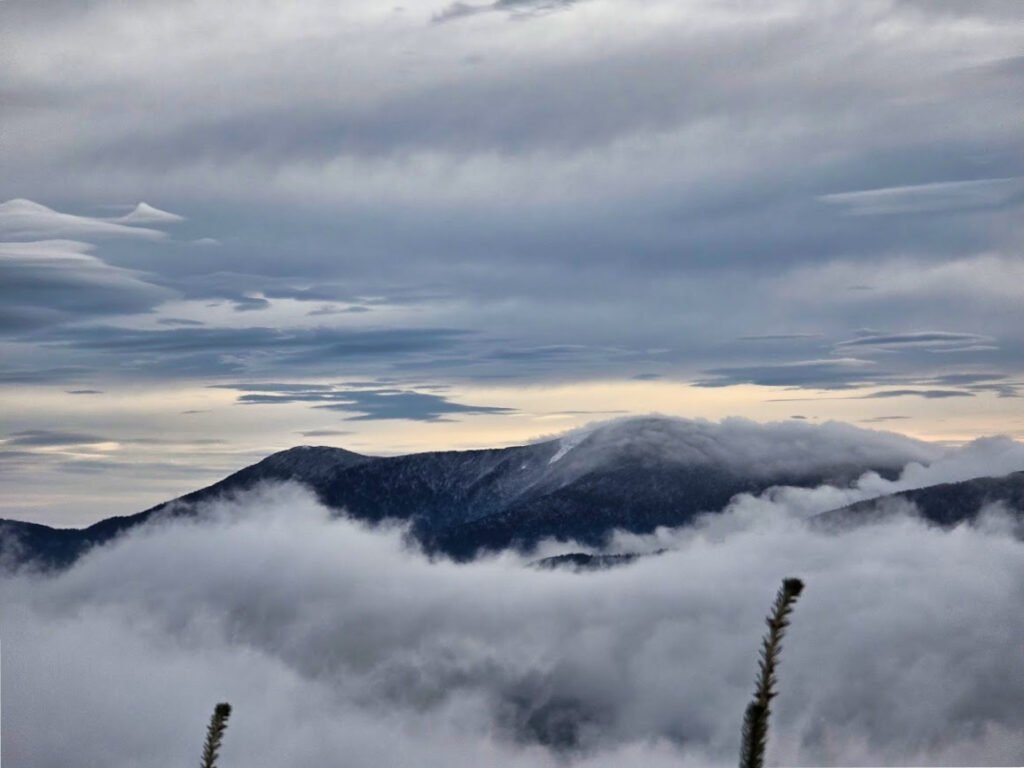
Mid-January 2025 we attempted to climb Mt Washington. We did not get to the top but it was an awesome experience anyway.
For those who do not know it – Mt Washington is a relatively low mountain in the White Mountains range in New Hampshire (some 3h away from Boston). Despite its low altitude, it is famous for some very mean weather, including some wind speed records and there are more rescues (and deaths) than you would expect from such a mountain.
During summer it is a rather boring mountain, considering there is a road going to the very top, so you can drive there. In winter though, it becomes a great mountain for those who want to explore easy technical mountaineering without travelling far away and dealing with altitude and challenges and acclimatization time which come with it.
Initially, I was thinking of doing this climb unguided, but reading reviews and because we had a child among us we decided to hire guides and also do the training session the day before the climb.
In the end, we settled on having it as an extended weekend adventure – arrive on Thursday by the end of the day; Training Day on Friday; Summit Attempt on Saturday and some additional activities and departure on Sunday.
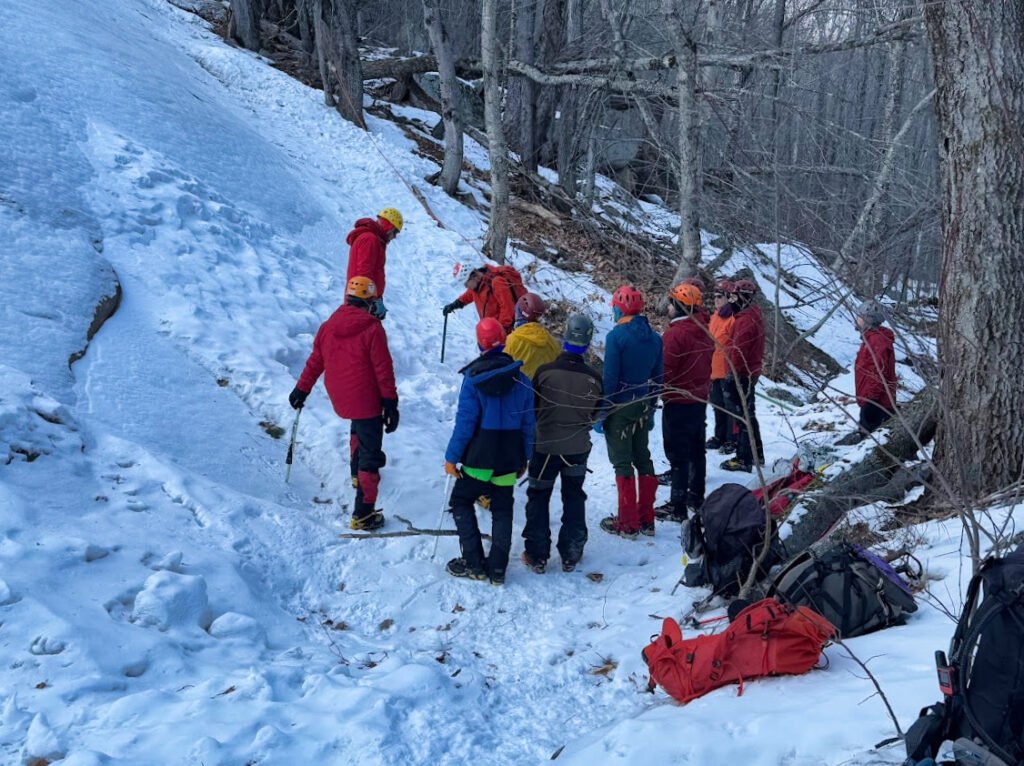 The training session was frankly not the best – the first part of the day we went through the gear, mainly on a theoretical level… there was no practical stuff like how folks show us how you pack a backpack, get your ice axe on it etc. In the second part of the day, we had a practical session to learn self-arrest and how to walk in crampons. While I would expected us to drive up to the altitude where there was some snow and ice, we stayed low, there were only very small patches of snow which we used for training, which was not as interesting or effective as other training I participated in. The most interesting part for me was learning how to use the rope for descent without the harness.
The training session was frankly not the best – the first part of the day we went through the gear, mainly on a theoretical level… there was no practical stuff like how folks show us how you pack a backpack, get your ice axe on it etc. In the second part of the day, we had a practical session to learn self-arrest and how to walk in crampons. While I would expected us to drive up to the altitude where there was some snow and ice, we stayed low, there were only very small patches of snow which we used for training, which was not as interesting or effective as other training I participated in. The most interesting part for me was learning how to use the rope for descent without the harness.
My biggest regret perhaps is we had this training day at all, as this is the day the weather actually was quite good and perhaps we would have done better just pushing for the mountain in the good weather and doing some additional skill polishing training the next day.
On Saturday, the forecast was increasing winds by the midday and the afternoon so we started early, around 5 AM. If it were me I would have started even earlier as love the crispy silent night and walking with headlamps… until you meet the sunrise and gorgeous views open up.
The Winter trail for Mt Washington starts at AMC Pinkham Notch Visitor Center – It was great to see free parking, no pass required and the “get ready” room for climbers open 24/7
The first part of the trail was easy walking – no crampons required. After some hours, we came to the start of Lions Head trail put on crampons and got out ice axes. I think we could do it 15-20min later, but perhaps for those of us doing crampons for the first time, it was good to start on easy terrain first.
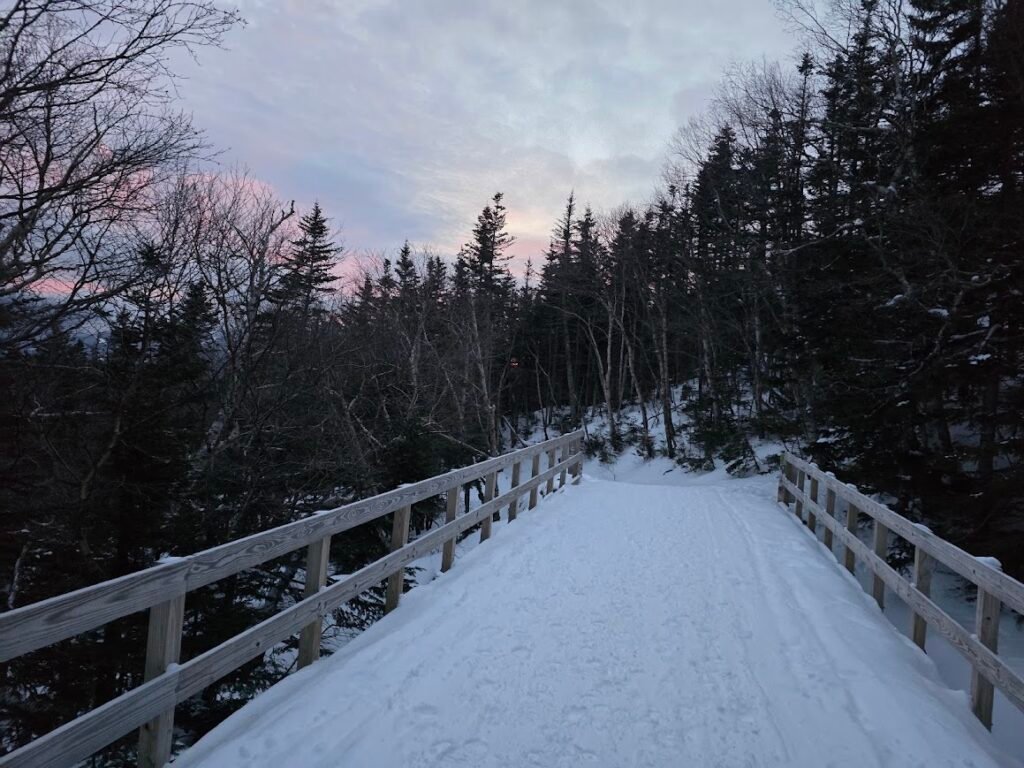
When there comes the steep section. It is wooded, meaning if you fall you’re unlikely to go down very far, on the other hand, you have very little time to self-arrest, before the tree “arrests” you, which might be quite unpleasant.
Our guides had to set up a rope in one of the places, which was pretty steep. I did not use it, though some others in our group did.
While we were in the trees, there was not a lot of wind… just an occasional sound of the wind blowing, as we got above the tree line we started to feel the wind blowing, though it was relatively mild. The trail very much flattened at that point and I do not really understand why Guides had us walking with ice axes – I think using crampons and poles would be preferred at that point.
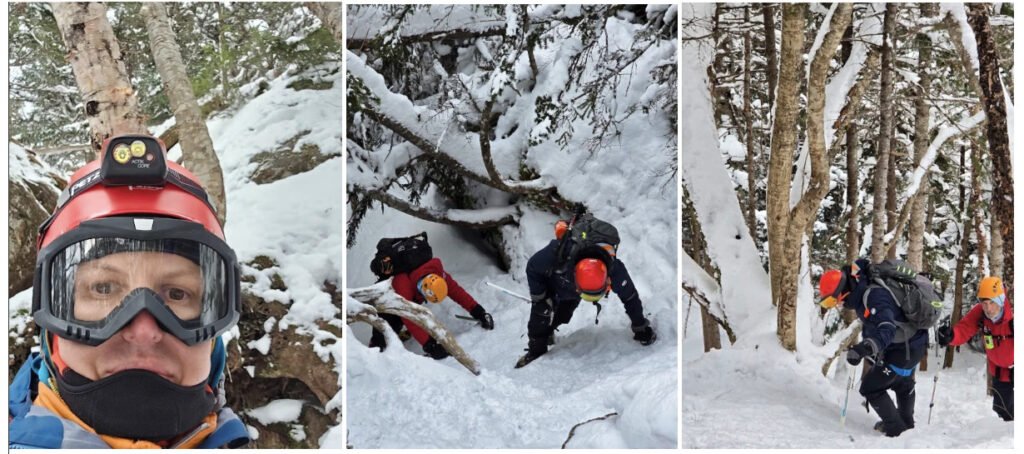
As we got higher up, getting closer to the Lion’s Head some of us were getting tired – Mountaineering is a very much endurance sport and you need to be sure you can keep the pace for many hours in a row. We were considering splitting the group with some of us going down… but decided to get all together to Lion’s Head and decide.
After the Lion’s Head, the trail goes by the open ridge for a while… which was Really Windy. Guides suggested we get out from the rocks to see how the wind feels…. And O boy it feels… I was kicked down from my feet by wind gusts before deciding it was unsafe to continue. This is the point we turned down. The weather station on the top of the mountain reported wind gusts of up to 95 mph (150+ km/h) at that time.
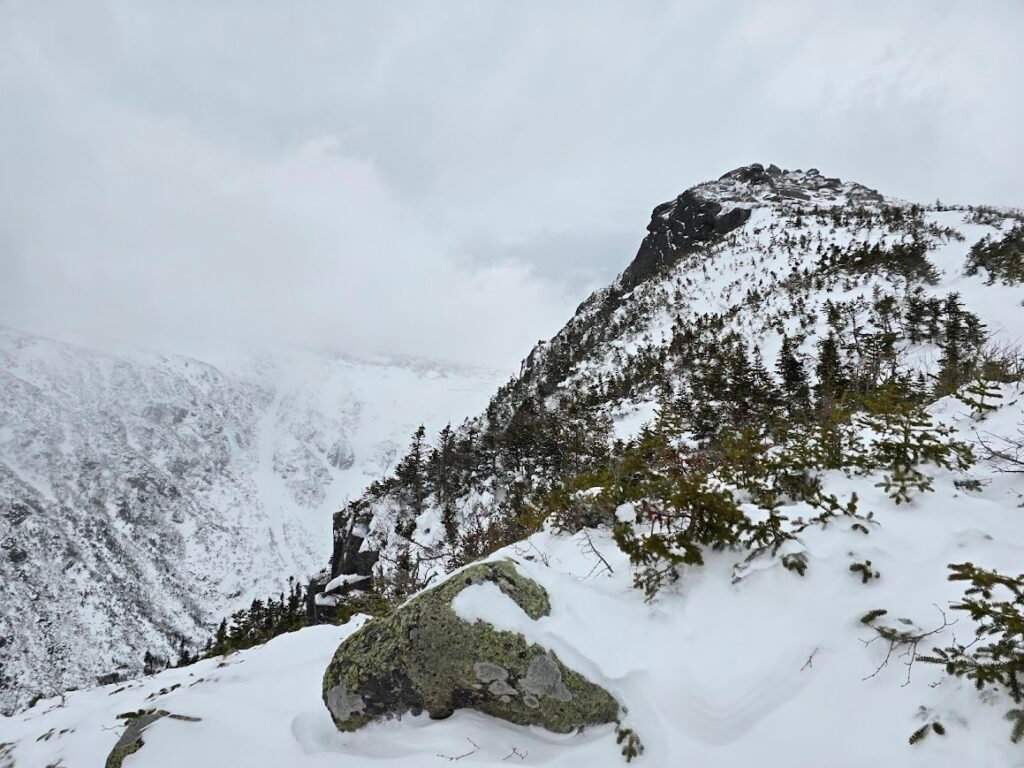
To go down we went the summer route as avalanche danger was not bad, per our guides, and it was pretty cool – navigating through the deep snow on a relatively steep slow.
As we got down below the tree line, nothing showed the windy hell up the mountain – it was Saturday and there were a lot of people hiking and skiing at the lower section of the mountain.
As we got back we discovered a significant storm was expected the next day afternoon which could close down Boston Airport and roads, so we all decided to depart early instead of doing a morning of winter activities.
Takeaways
Even though we did not make it to Mt Washington summit, I still think it is a good beginner mountain for experienced hikers looking to try their hand at mountaineering. Now I’ve been through the main technical section of the train I also would be comfortable doing it on my own.
I’m surely planning to get to Mt Washington Summit in Winter – perhaps I should look at the weather and do last last-minute quick weekend trip to climb it sometime.
If you would like us to repeat the trip as a Geeks Go Peaks adventure too, let us know!
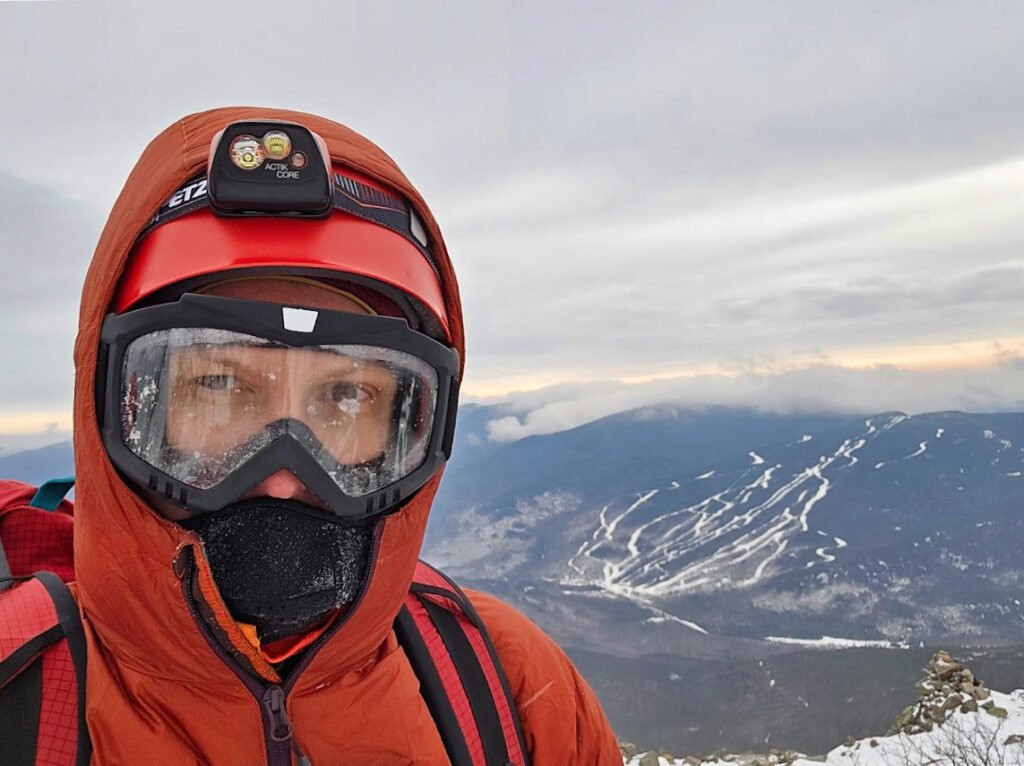
The post Climbing Mt Washington in Winter appeared first on Peter Zaitsev.
How I Fly 21 Feb 4:48 AM (2 months ago)

I fly a fair amount – both for business and for pleasure, domestically (in the US) and internationally. This document outlines some “best practices” which I found working well for me. I am a frugal value-seeking traveller – I do not pay for “Business Class” unless it is some very cheap last-minute paid upgrade, though I get upgraded because of my airline status sometimes.
- Stops are risky (of missed connections) and waste time, so fly direct or minimize the number of stops, even if it is slightly more expensive
- For pricing, I look at the cost of the ticket and the difference between the preferred airline and the cheapest ticket available now. For me, if it costs below $400 to fly domestically and $1000 for an International ticket, I just buy my preferred Airline (Delta or other SkyTeam airlines) if it is more expensive than that I’m OK with roughly 30% premium for the most convenient ticket.
- Having chosen an airline (Delta in my case) is a good idea – as you earn airline status you get some perks, most important of which for me is quick access to the human in case something goes wrong with the travel. In the past, I’ve wasted so much time waiting on the phone or trying to chat with airlines to rebook my travel or deal with other issues… and still do flying with airlines where I have no status. But even besides that sticking to the same Airlines means you get to know its route network better and know how to navigate connection airports easily, saving time and energy
- Access to Clubs can make travel much more pleasant and also save on airport food, especially travelling internationally as clubs outside of the US tend to have better food options. I get access to a lot of SkyTeam clubs through Delta Status (though it can be confusing which exactly) and have a Priority Pass through my credit card.
- Travel Early. I prefer to take the first flight even if it requires a very early start. These flights tend to have fewer delays and cancellations… and if something goes wrong there is a whole day ahead of you to be rebooked.
- Avoid Redeye. I do not sleep well on the plane and will be quite grumpy if I did not sleep the night before. It is pretty impossible going to Europe or Asia though and Jetlag will make me miserable for a while anyway.
- Arrive in the US at my local RDU Airport. While this is not always possible, it is awesome – passport control in RDU is a breeze.
- Know your connecting airports – I like Atlanta (ATL) and hate layovers in JFK as a personal preference. Know the connection time actually needed, especially if security check and passport control are required – I’ve seen airlines suggesting itineraries which would be so tight even a minor delay means you’re missing a connection.
- Look for connecting airports with multiple daily flights when possible, so if you’re late you’re likely rebooked on a later flight instead of needing to wait another day or add a stop.
- Check weather in connecting airports – if there is a high risk of a storm or hurricane you may be better off changing your flight through a different airport before official notice and a mad rush of people trying to make changes. This is especially great if there are no change fees.
- Fly with carry-on only. I am always on the lookout for a maximum-size suitcase and backpack which I can get away with. Checked baggage can get lost, you waste time waiting for it and it also limits your flexibility to adjust your flight if you’re on the way.
- Have a plan if WiFi does not work. Unfortunately, the availability and reliability of this service have a lot to be desired
- Watch inbound flights – this works especially well in the US with services like FlightAware – in so many cases I can see inbound flights being delayed and make alternative arrangements before flight delay is officially announced
- Choose seats in advance. Otherwise, you might be assigned quite a poor one. Here are a few tips:
○ Choose seats closer to the front, this can save 10+min, which can be important especially if connection time is tight
○ Emergency Row seats and Front row seats can be awesome, some have just an insane amount of legroom, though a fixed seat divider might be a liability if you happen to have an empty row.
○ On long flights checking seat-map during check-in can help you to spot where empty seats are likely and move there
○ If travelling with a companion taking window and aisle seats increases the chance no one will be travelling in the row with you… and if you get someone on that seat you can usually offer them an aisle seat and sit together.
While many flights these days have virtually no penalty for booking one way, some flights between the US and Europe may cost more one way than return. This does not make sense but this is how it is. In such cases, I book a return and when to cancel the return portion of the ticket for flight credit
Hope you find some of those tips helpful!
The post How I Fly appeared first on Peter Zaitsev.
How come not everyone is an Angel Investor? 3 Feb 7:51 AM (2 months ago)

Personally, I love Angel Investing! Not only does it provide an opportunity for outsized returns (if you’re making good choices) but also, compared to being LP in the early-stage Venture Fund it often allows you to have a direct line to founders, which tends to be awesome, and an opportunity to contribute to business success.
Yet as I found helping to organize Coroot “Family and Friends” pre-seed round, not everyone thinks this way! Even among my high net worth connections who have capital available, many are not interested, even before they know the project. Sometimes the reason is the lack of time they need to evaluate if it is a good investment or not being familiar with the logistics of making such investments, in many cases though I think it is something different…
Early stage Angel Investing is not different to other early-stage investments, such as those done by VC funds – overall most startups fail, resulting in complete capital loss, and even if you’re good at picking winners you will have to deal with large amounts of failures and many people… just do not like it. Even worse, while failures often happen within the first 1-3 years after investment, you may need to wait 5+ years for that runaway success to fully materialize, making perception even worse than reality.
Investing in some form of early-stage fund, which makes a substantial amount of investments makes failures less visible and also with regular NAV calculations can make you feel good about unrealized investments quite early in the game.
This reminds me that Entrepreneurs, like me, tend to have a higher risk tolerance and ability to deal with failures – it is an important part of the entrepreneurial journey, though I’m probably more risk-tolerant than average even among this group.
If you like Angel Investing as an idea but are not sure where to start and how to stomach it, I would suggest starting by thinking about it as Gambling but with higher expectations of returns and possibly even more fun. If you’re OK losing $1000 in Las Vegas you probably will be OK losing it on your Angel Investment too. Start with your play money, not retirement money, especially before you get a feel for how it works for you.
The other good practice is to build a portfolio of investments, rather than have a single investment and look at portfolio, rather than single investment performance – some 20 investments would be a good start.
Finally, you may want to spread your investments in time over multiple years as for various reasons some years may turn out better than others.
This may sound like a significant amount of work, and it is -work tends to be required to achieve good long-term outcomes in about every field. It is essential if the financial results of your Angel Investing are your primary goal, which it might not be, it is not uncommon to do a small number of “investments” in businesses led by family or friends with the primary focus of supporting them or supporting the mission of the company – many contribute to charities after all, where no direct financial return is expected.
If you invest in your Family or Friend’s business for this reason, I would suggest asking yourself a question whenever investment loss is likely to ruin your relationships, and if it is worth it in the end. Thinking about such an investment as a gift may help.
I’m having fun doing Angel Investments and I think more people can have fun and profit from doing it too!
The post How come not everyone is an Angel Investor? appeared first on Peter Zaitsev.
Thoughts on ScyllaDB License Change 25 Dec 2024 11:15 PM (4 months ago)

As you may have heard, ScyllaDB is moving to a Source Available License. Seeing this move from so many companies from MongoDB to Redis should not surprise everyone. This is what happens to “corporate-owned” Open Source Software these days. Yet it is interesting to explore ScyllaDB’s situation in more detail.
First, I think ScyllaDB’s license change is much more similar to MongoDB’s move to SSPL back in 2018, rather than Elastic or Redis license changes. With ScyllaDB using AGPL license its Open Source version already was not “Embedding Friendly” and as such the license change does not pull the rug from so many Independent Software vendors as often happens when software previously licensed under permissive license (APL, BSD, MIT etc) goes source available.
I’m also aware if there has been a substantial contributor community for ScyllaDB – the number of contributors at Github is 157 as I write this, and most are probably employees and affiliates, compare this to almost 2000 contributors to ElasticSearch
This means it is unlikely ScyllaDB will be forked in any meaningful way as it happened with Redis (Valkey) or ElasticSearch (OpenSearch).
I did a quick poll on LinkedIn and here are the results:
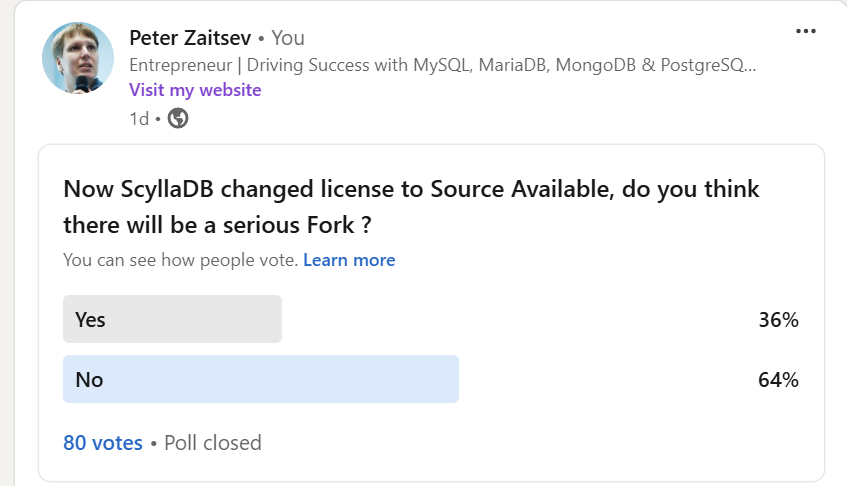
Roughly a third of folks think ScyllaDB will get a serious fork (not just fork on GitHub), I think the probability is much much lower, for the reasons stated.
I think it is also interesting to take a look at what is happening to ScyllaDB popularity per DB-Engines
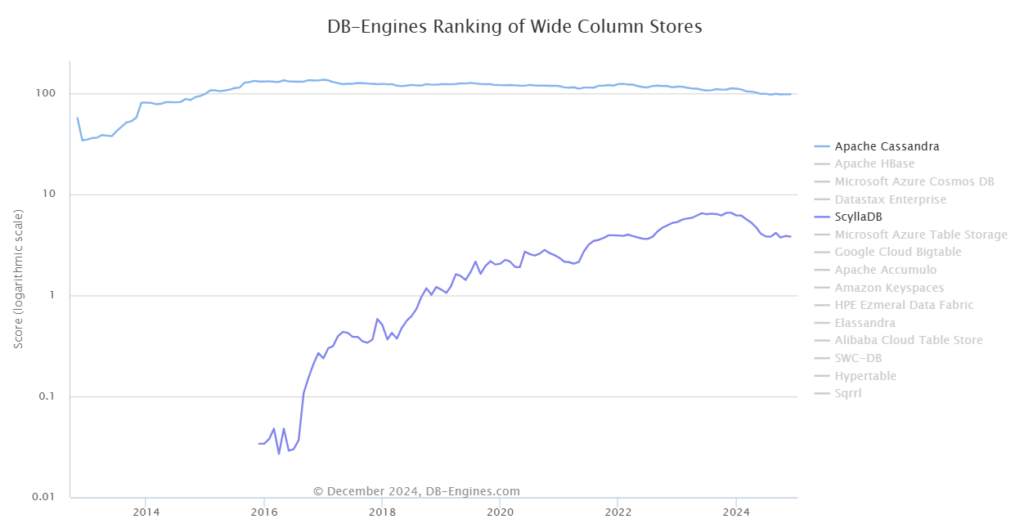
First to note DB-Engines measures “Popularity” which does not always correspond to the “Revenue” the technology ecosystem generates. For example, while MongoDB has been in a Down Trend for a while MongoDB Inc revenue is still growing.
What this shows though, is that the fast growth that the Open Source community is so good at supporting is gone. It is natural for a company to shift focus on monetization, to ensure more technology users are paying customers… and also existing customers are paying more because the Source Available “free as in beer” version will be an acceptable alternative for fewer of them.
Something is interesting in the ScyllaDB announcement though – focusing on the single release stream “ScyllaDB Enterprise” which will change from “conventional proprietary” to “source available proprietary”, giving access to Enterprise Features in the free tier – smaller deployments (see FAQ).
This makes ScyllaDB’s Source Available license very different from ones used by MongoDB and Redis – where they tend to focus on a “Non-Compete” angle and their Source Available license allows some users to use software for free at any scale, ScyllaDB basically requires any serious large scale user to have Commercial Enterprise License. This is similar to the CockroachDB approach yet actually less restrictive – allowing for some production use, not just development and prototyping.
It is also interesting to see ScyllaDB’s stated reasons to go source available – it is not “unfair competition” and need for “everyone to pay their fair share” but rather simplifying the development process – no need to maintain multiple versions of multiple components.
While I do not have any inside information on this topic, I can speculate ScyllaDB is looking for a path to go public and a nice (if short-term) revenue boost this license change can provide can be helpful.
I’m disappointed that such an awesome piece of engineering is leaving the Open Source ecosystem. This surely leaves a gap and with the ScyllaDB fork unlikely I would not be surprised if some other Open Source solution will rush to fill this space.
As of now though, if you can’t use ScyllaDB anymore because of the license change you may want to re-visit Cassandra, which promises significant performance improvement with Cassandra 5 release, or take a look at YugabyteDB which has Cassandra compatibility.
The post Thoughts on ScyllaDB License Change appeared first on Peter Zaitsev.